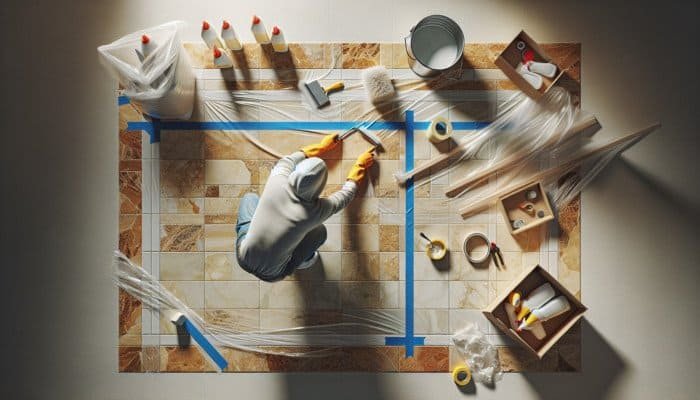Unveiling the Allure and Advantages of Travertine Tile
Travertine Tile Cleaning: Travertine is a stunning natural stone that has gained widespread acclaim for its unique texture and aesthetic qualities, making it a popular choice for flooring and wall cladding in residences across the United Kingdom. This versatile material, formed through the gradual build-up of mineral deposits in hot springs, emits a warm and inviting ambience that seamlessly fits both modern and traditional interior styles. Furthermore, its inherent porous nature not only enhances its visual charm but also presents specific cleaning challenges. Therefore, having a comprehensive understanding of its properties is crucial for homeowners aiming to preserve its beauty and functionality.
Understanding the Distinctive Features of Travertine

Travertine is categorised as a sedimentary rock, primarily consisting of calcium carbonate, which forms from the accumulation of minerals in natural springs or hot springs. Each piece of travertine boasts its own unique characteristics, showcasing variations in colour, pattern, and texture. This individuality adds to its appeal, infusing sophistication into any environment it graces. Often found in upscale residential and commercial spaces, travertine tiles are esteemed for their impressive durability and elegant appearance. In the UK, it is common to find travertine flooring in various settings, from luxurious bathrooms to stylish entryways, highlighting its flexibility.
Despite its renowned durability, the porous nature of travertine can make it susceptible to staining and discolouration if not cared for properly. Therefore, understanding the best way to clean travertine tile is essential. Regular maintenance not only preserves the stunning appearance of the tiles but also prolongs their lifespan. If neglected, the build-up of dirt, grime, and spills can lead to irreversible damage, resulting in costly repairs or replacements that can be easily prevented with proper upkeep.
Examining the Various Finishing Options for Travertine
Travertine is available in an array of finishes, each requiring specific care and maintenance methods to ensure longevity. The three primary types—honed, polished, and tumbled—offer distinct aesthetics and cleaning requirements. Honed travertine is treated to achieve a matte finish, providing a soft, natural look that is less slippery, making it a favoured choice for flooring in residential environments. Cleaning honed travertine is relatively straightforward, generally involving the use of gentle detergents and soft cloths.
In contrast, polished travertine features a shiny finish, which enhances the stone’s colour and patterns. While it is visually striking, polished surfaces are prone to scratching and necessitate careful cleaning to maintain their lustre. The best practices for preserving polished travertine include using a pH-neutral cleaner and soft mops to avoid abrasions that could dull its finish over time.
Tumbled travertine, distinguished by its textured surface, is frequently chosen for outdoor areas like patios. Its rugged texture effectively conceals dirt but may trap grime within its crevices. Cleaning tumbled travertine requires a more thorough approach, involving gentle scrubbing with a soft brush and suitable cleaning solutions to ensure that all dirt is removed without causing harm to the stone. Understanding the differences among these finishes can significantly aid homeowners in selecting the appropriate cleaning methods, helping their travertine tiles maintain their exquisite beauty for years to come.
The Vital Necessity of Consistent Cleaning
Establishing a routine cleaning regimen for travertine tiles is not merely a cosmetic issue; it is crucial for safeguarding the integrity of the stone. Without regular maintenance, dirt and organic matter can accumulate within the stone's pores, leading to discolouration and structural degradation over time. A well-maintained travertine surface is not only more visually appealing but also more durable. Still, it is also less likely to suffer from wear and tear, which is particularly important in high-traffic areas of the home.
In addition to aesthetic considerations, neglecting to clean travertine can result in expensive repairs. Stains from spills—such as wine, oil, or acidic substances—can seep into the stone if not promptly addressed. Implementing a regular cleaning schedule, which includes the best way to clean travertine tile, can help avert these issues, making it a sound investment in the upkeep and longevity of your home.
Another crucial aspect of cleaning travertine is the prevention of mould and mildew, particularly in humid areas like bathrooms or around swimming pools. Consistent cleaning and sealing can significantly lower the risk of these problems, ensuring that your living spaces remain hygienic and safe for both family and guests.
Implementing Efficient Cleaning Techniques for Travertine

Employing effective cleaning practices is essential for maintaining the beauty and durability of travertine tiles. Gentle, pH-neutral cleaners are crucial; these products are specifically designed to remove dirt without damaging the stone’s surface. Refraining from using acidic or abrasive cleaners is vital, as these can etch and dull the finish, resulting in a gradual loss of beauty over time.
During the cleaning process, always opt for soft cloths or mops to avoid scratching the tile surfaces. Microfibre cloths, in particular, are highly effective for trapping dirt and dust without the need for harsh scrubbing. Establishing a gentle cleaning routine that involves sweeping or vacuuming to remove debris before mopping can effectively prevent scratches while preserving the pristine condition of your travertine tiles.
Furthermore, regular sealing of travertine tiles boosts their resistance to stains and moisture. It is advisable to apply a travertine-specific sealant every few years, particularly in high-traffic areas. By combining these practices, homeowners can ensure that their travertine tiles continue to be a stunning focal point, showcasing both beauty and functionality.
Key Preparatory Steps for Cleaning Travertine
Successful cleaning begins with adequate preparation. Before cleaning, it is vital to gather all necessary supplies and protect your environment. A little preparation can significantly enhance the effectiveness of your cleaning efforts, especially with a delicate material like travertine.
Gathering Essential Supplies for Travertine Cleaning
Having the right supplies is critical for effectively cleaning travertine tile. Begin by acquiring a soft broom or a vacuum cleaner specifically designed for hard surfaces. These tools will assist in removing dust and debris without scratching the stone. Additionally, a mild detergent formulated for natural stone should be included in your cleaning toolkit to ensure the solution is safe for use on travertine.
Alongside these basic items, warm water is essential for effective cleaning. It activates the cleaning solution and loosens dirt efficiently. You will also need a bucket to mix your cleaning solution, soft cloths or microfibre mops for application, and a soft brush for deeper cleaning tasks. Investing in high-quality cleaning tools simplifies your efforts and yields superior results, ensuring your travertine remains in immaculate condition.
Protecting Surrounding Areas During Cleaning

When preparing to clean travertine tiles, it is crucial to safeguard surrounding areas to avoid accidental damage. Employing painter’s tape to cover skirting boards, furniture, and other surfaces that could be affected by cleaning solutions is a wise precaution. Additionally, consider using plastic sheeting to protect larger areas, particularly if you are utilising deep cleaning or more intensive techniques.
This precautionary measure is vital, as cleaning solutions can sometimes splatter or drip, leading to unwanted stains on wood or other materials. By protecting these areas, you not only facilitate a more effective cleaning process but also prevent any unnecessary stress or expense related to damage caused by cleaning products.
Ensuring Safety During the Cleaning Process
Cleaning travertine tiles requires careful handling of the stone and ensuring your safety throughout the process. Always wear gloves to protect your hands from any chemicals present in the cleaning solutions, even if they are pH-neutral. This simple measure can prevent skin irritation and keep your hands looking their best.
Good ventilation is essential when using any cleaning products. Open windows and doors to promote fresh air circulation in the area, especially if you are using stronger cleaning agents. This practice helps to disperse fumes and creates a safer work environment. By observing these safety precautions, you can ensure a smooth cleaning process while protecting both yourself and your beautiful travertine tiles.
Best Practices for Cleaning Travertine Tiles
Understanding effective cleaning techniques is key to preserving the beauty and longevity of travertine tiles. Employing proper methods can significantly enhance the appearance of your flooring while safeguarding it from damage. Below, we explore the best practices for daily cleaning, deep cleaning, and managing stain removal effectively.
Creating an Effective Daily Cleaning Routine for Travertine
Establishing a daily cleaning routine is foundational for maintaining travertine tiles. Regularly sweeping or vacuuming the floor aids in preventing the accumulation of dirt and debris, which can lead to scratches when walked upon. A soft-bristled broom is ideal for this purpose, or you may choose a vacuum cleaner equipped with a hard-surface attachment to ensure gentle yet effective cleaning.
In addition to controlling dust, wiping down the tiles using a damp microfibre cloth or mop is advisable. This simple action removes any remaining dust while preventing streaks and grime build-up. It’s particularly beneficial to perform this task in the evening or early morning when foot traffic is lower, allowing for a thorough clean without interruptions.
This routine becomes even more critical for households with pets or young children. Spills from food, beverages, and pet accidents can quickly lead to staining if not promptly addressed. By adhering to a consistent daily cleaning regimen, you help preserve the beauty of your travertine tiles while creating a healthier living environment for everyone in your home.
Executing a Thorough Deep Cleaning Process for Travertine
While daily cleaning is vital, deep cleaning is sometimes necessary to restore the vibrancy of travertine tiles. To facilitate a thorough clean, remove all furniture and obstacles from the area. Mix a gentle detergent with warm water in a bucket, creating a practical yet mild cleaning solution.
Using a soft brush, scrub the tiles in a circular motion, paying special attention to grout lines and any areas exhibiting visible stains or discolouration. The key to this process is to be gentle; aggressive scrubbing can damage the surface of the tiles. After scrubbing, rinse the area thoroughly with clean water to eliminate any detergent residue, which could result in sticky surfaces if left behind.
Once the deep cleaning is complete, use a dry microfibre cloth to wipe down the tiles, removing any excess moisture. This final step is crucial, as leaving water on the surface can create unsightly water spots, which may lead to further issues such as mould growth in damp areas. Deep cleaning your travertine tiles rejuvenates their appearance and contributes to a healthier home environment.
Effective Strategies for Stain Removal on Travertine
Stains can pose a common concern for travertine tile owners, but they can be effectively managed with the right approach. A poultice made from baking soda and water can be highly beneficial for oily or greasy stains. Apply a thick paste directly to the stain, covering it with plastic wrap to maintain moisture. Allow the poultice to sit in place for several hours, or overnight if dealing with particularly stubborn stains.
After the designated period, gently scrape away the poultice using a plastic scraper and rinse the area with warm water to eliminate any residue. A similar technique can be employed for organic stains, such as those from coffee or wine, substituting hydrogen peroxide for water in the poultice.
Addressing stains promptly prevents them from setting in. Regular sealing of your travertine tiles will further assist in stain prevention, providing additional protection against spills and discolouration. By employing these stain removal tips, your travertine tiles can retain their elegance and charm for many years.
Drying and Finishing Techniques for Travertine Tiles
After cleaning travertine tiles, the drying and finishing stages are crucial for achieving a polished, professional appearance. Proper drying not only enhances their visual appeal but also helps protect them from potential damage. This section outlines the best practices for drying, applying sealant, and adding the finishing touches to your travertine tiles.
Utilising Proper Drying Methods for Travertine
Once cleaning is complete, it is essential to ensure that your travertine tiles are thoroughly dried to avoid unsightly water spots or streaks. Use a clean, dry microfibre cloth to wipe down the tiles, effectively absorbing any excess moisture. This step is vital, as lingering water can lead to issues like discolouration or mould growth, particularly in damp areas such as bathrooms.
If possible, promote fresh air circulation by opening windows or using fans to accelerate drying. Avoid using heat sources such as hair dryers or heaters, as these can cause thermal shock to the natural stone, potentially leading to cracks or other damage. Proper drying is not just about aesthetics; it protects the integrity of your travertine tiles, ensuring they continue to enhance your home for years to come.
Applying a Protective Sealant to Travertine
Applying a high-quality travertine-specific sealant is vital for safeguarding your travertine against stains and moisture. This procedure should be conducted every few years, depending on foot traffic and exposure to moisture. Before application, ensure that the tiles are completely dry after cleaning. Once dry, adhere to the manufacturer’s instructions for the sealant application.
Typically, the sealant should be applied using a clean applicator or cloth, working in small sections to ensure even coverage. Pay particular attention to grout lines, which can be especially vulnerable to staining. After application, allow the sealant to cure as directed, which may take several hours or even days, depending on the product used. Regularly sealing your travertine tiles can significantly prolong their lifespan and maintain their stunning appearance.
Adding the Final Touches to Travertine Tiles
Once the tiles are cleaned and sealed, the final touches can profoundly impact the overall look and feel of your flooring. Gently buffing the tiles with a clean, dry cloth will enhance their natural shine, imparting a polished and sophisticated appearance. This simple step can elevate the aesthetic of any room, ensuring your travertine floors remain a focal point of elegance.
Consider applying a fine-grit polishing compound specifically designed for natural stone for added lustre. Apply it evenly with a soft cloth, adhering to the manufacturer’s guidelines for optimal results. This practice will help to enhance the depth of colour and pattern inherent in your travertine tiles, making them an even more stunning feature of your home.
Lastly, please do not overlook the grout lines; clean and reseal them annually to prevent discolouration and build-up. Maintaining the integrity of the grout improves the overall appearance and protects the tiles from moisture, ensuring they remain beautiful for years to come.
Steering Clear of Common Mistakes in Travertine Tile Care
Certain pitfalls can lead to costly errors and damage when maintaining travertine tiles. By being aware of these common mistakes, you can ensure that your tiles remain in pristine condition and continue to enhance your home for years to come.
Refraining from Harsh Chemicals on Travertine
One of the most significant errors homeowners make is using harsh chemicals on travertine tiles. Acidic cleaners, bleach, or abrasive scrubs can cause irreversible harm to the stone, resulting in dullness, etching, and discolouration. To ensure the longevity of your tiles, it is essential to select cleaners that are pH-neutral and specifically formulated for natural stone.
Before applying any cleaning product, always test it in an inconspicuous area to assess its effects. This precaution can prevent potential disasters and help maintain the integrity of your beautiful travertine tiles.
Avoiding Excessive Moisture on Travertine Tiles
Another common mistake is over-wetting the tiles during the cleaning process. Excessive water can penetrate the porous surface of travertine, leading to discolouration and potential structural damage over time. Always use a damp cloth or mop rather than saturating the tiles when cleaning. This controlled approach will help to preserve the stone’s natural beauty while also preventing long-term damage.
Furthermore, ensure that the tiles are thoroughly dried after cleaning to eliminate any lingering moisture. This practice is critical for maintaining the integrity of the stone, particularly in areas prone to dampness.
Maintaining a Consistent Maintenance Schedule
Consistency is key when it comes to caring for travertine tiles. Neglecting regular cleaning and maintenance can lead to a build-up of dirt and grime, making it increasingly difficult to restore the tiles to their original splendour. Establishing a routine cleaning schedule is essential; regular sweeping, mopping, and deep cleaning every few months will keep your travertine looking its best.
Additionally, schedule professional inspections of your tiles to catch any potential issues early. This proactive approach saves time and money while helping to ensure that your travertine tiles remain a beautiful feature of your home for many years.
Ensuring Adequate Sealing of Travertine Tiles
Failing to seal travertine tiles properly is another common mistake that can have serious repercussions. Sealant acts as a protective barrier, preventing stains and moisture penetration. Without it, your tiles risk discolouration and damage from spills or humidity.
Make it a priority to reseal your travertine tiles every few years, or more frequently if the tiles experience heavy foot traffic or exposure to moisture. This simple yet effective measure will help preserve the beauty and longevity of your travertine, ensuring it continues to be a stunning element of your home.
Advantages of Engaging Professional Cleaning Services for Travertine
While many homeowners prefer to manage the cleaning of their travertine tiles independently, there are circumstances when seeking professional assistance is advisable. Recognising when to enlist expert help can save time and ensure your tiles receive the utmost care.
Determining When to Call in the Professionals
If you encounter stubborn stains or heavily soiled tiles, it may be time to consider hiring professional cleaning services. Experts possess access to specialised equipment and cleaning solutions that can effectively tackle deep-seated dirt and stains without risking damage to the travertine.
Moreover, suppose your tiles have not been cleaned or sealed for several years. In that case, a professional service can provide a thorough deep clean and apply a fresh sealant, rejuvenating your travertine to its original splendour. When in doubt, do not hesitate to seek expert assistance.
Selecting the Right Professional Cleaning Service
When choosing a professional cleaning service for your travertine tiles, it is crucial to select a company that specialises in natural stone care. Look for reviews and testimonials from past clients to ensure the company has a positive reputation and a proven track record.
Inquire about their cleaning methods and the products they use. A reputable service should willingly provide information regarding its cleaning solutions and processes. This ensures that your travertine receives the appropriate care, safeguarding your investment in your home.
Understanding the Cost and Frequency of Professional Cleaning
Engaging professional cleaning services can represent an investment, with costs varying based on the size of the area and the level of cleaning required. On average, homeowners can expect to pay between £2 and £4 per square foot for professional cleaning services. However, this expense can be offset by the longevity and beauty afforded through proper care.
It is advisable to schedule professional cleaning every few years, particularly if your tiles are in high-use areas. Regular maintenance by professionals ensures that your travertine tiles remain in optimal condition, preserving their aesthetic appeal and extending their lifespan.
Benefits of Choosing Professional Cleaning Services
A professional cleaning service can greatly enhance the appearance of your travertine tiles. Professionals possess the expertise and tools necessary to eliminate dirt and stains that routine cleaning methods may overlook, guaranteeing a deeper clean.
Additionally, professional cleaning can prevent future issues by applying appropriate sealants and treatments, protecting your tiles from moisture and stains. This level of care not only revitalises the appearance of your travertine but also preserves its integrity for many years to come.
Comparing DIY Cleaning with Professional Services
While DIY cleaning can be effective for routine maintenance, it is essential to acknowledge the limitations of at-home methods. Professional cleaning services offer the expertise and equipment necessary for deep cleaning and addressing specific concerns that may arise with travertine tiles.
Ultimately, the most effective approach is a combination of DIY maintenance and occasional professional cleaning. Regular upkeep will preserve the beauty of your travertine tiles, while professional services can address deeper issues, ensuring that your tiles remain a statement of elegance in your home.
Common Queries Regarding Travertine Tile Maintenance
What is the recommended frequency for cleaning my travertine tiles?
It is advisable to clean travertine tiles at least once a week for regular upkeep and perform deeper cleaning every few months, depending on foot traffic and usage.
Can I use vinegar to clean my travertine tiles?
No, vinegar is acidic and can damage travertine tiles. Always opt for pH-neutral cleaners specifically formulated for natural stone.
What methods are effective for removing tough stains from travertine?
For challenging stains, utilise a poultice made from baking soda and water. Apply it to the stain, cover with plastic wrap, and allow it to sit for several hours before cleaning it off.
Is sealing travertine tiles a necessary step?
Yes, sealing is crucial for protecting travertine from stains and moisture. It is recommended that you seal your tiles every few years or as needed, depending on usage.
What type of mop is most suitable for cleaning travertine?
A soft microfibre mop is ideal for cleaning travertine tiles as it is gentle on the surface and effective at trapping dirt and dust.
Are steam cleaners safe for use on travertine?
Steam cleaners are not recommended for travertine, as the high heat and moisture can cause damage. Stick to gentle cleaning methods for optimal results.
What should I do if I notice cracks in my travertine tiles?
If cracks appear in your travertine tiles, it is advisable to consult a professional for assessment and repair to prevent further damage.
How can I prevent water spots from forming on my travertine tiles?
To prevent water spots, dry the tiles thoroughly after cleaning and ensure proper ventilation in damp areas to minimise moisture accumulation.
Is it acceptable to use a regular mop and bucket to clean travertine?
Yes, but ensure the mop is soft. To avoid damaging the tiles, use a mild, pH-neutral cleaner mixed with warm water.
What is the typical curing time for travertine sealant?
Curing time for travertine sealant can vary, but generally, it takes approximately 24 to 48 hours for a complete cure. Always follow the manufacturer’s instructions for best results.
Last Updated on 26 September 2025 by sitemanager
The post Travertine Tile Cleaning Made Easy: Expert Tips & Tricks appeared first on https://tilecleaningsurrey.co.uk

